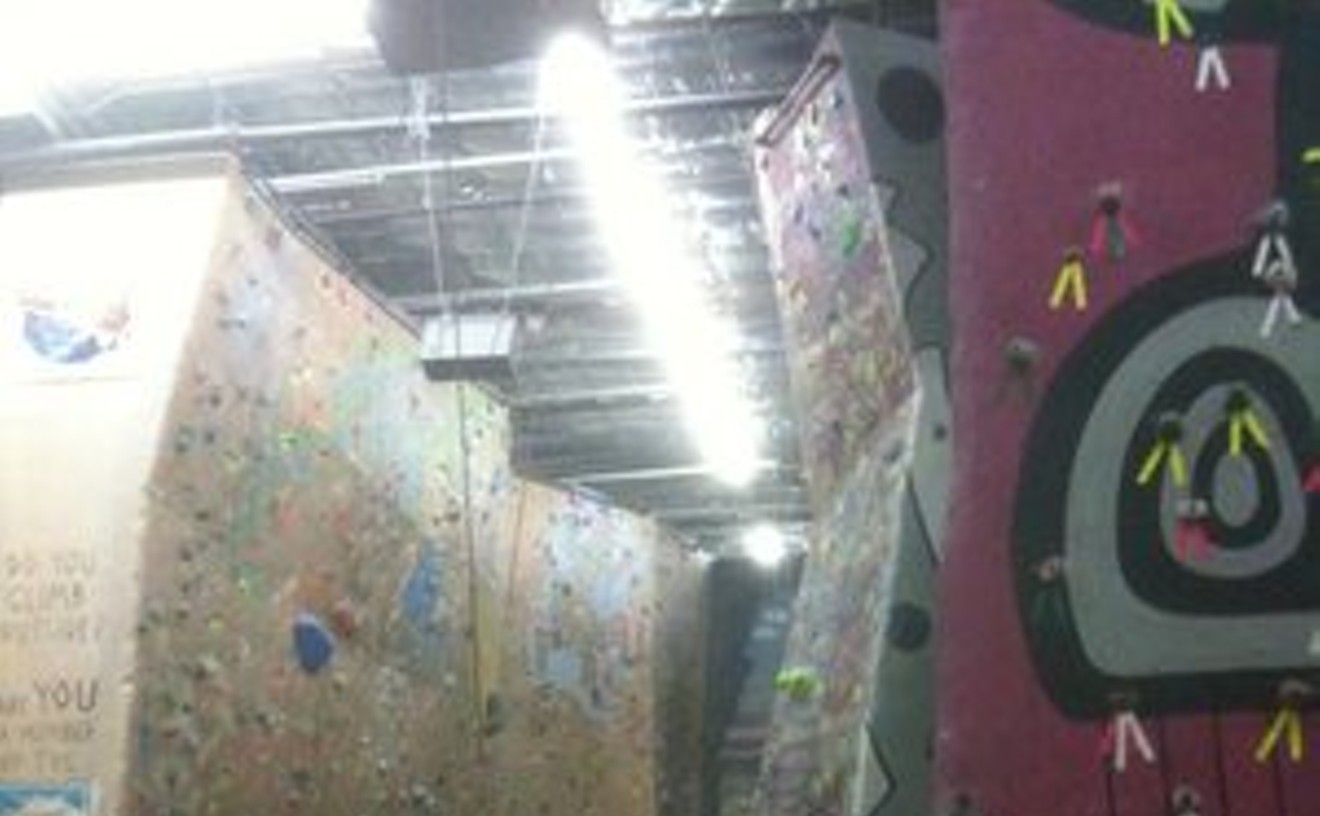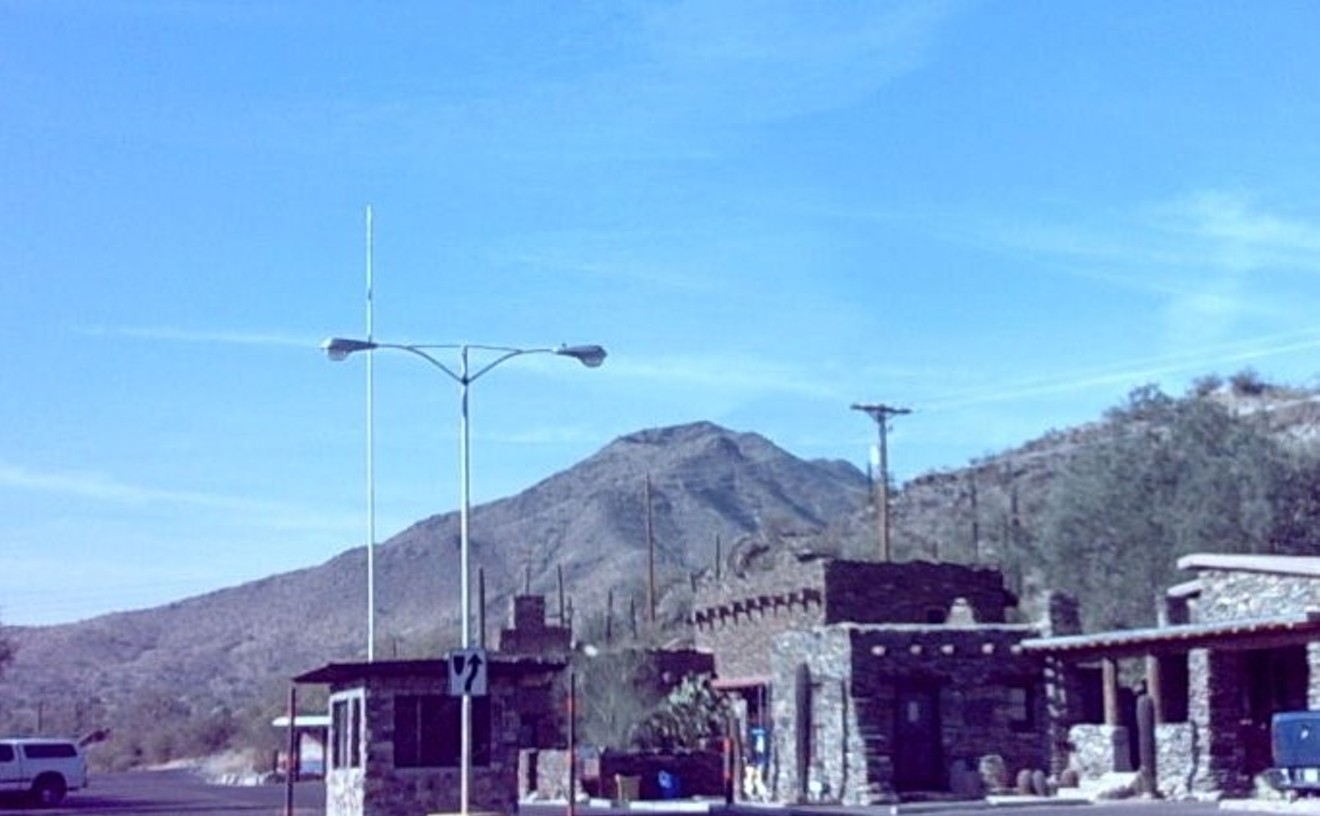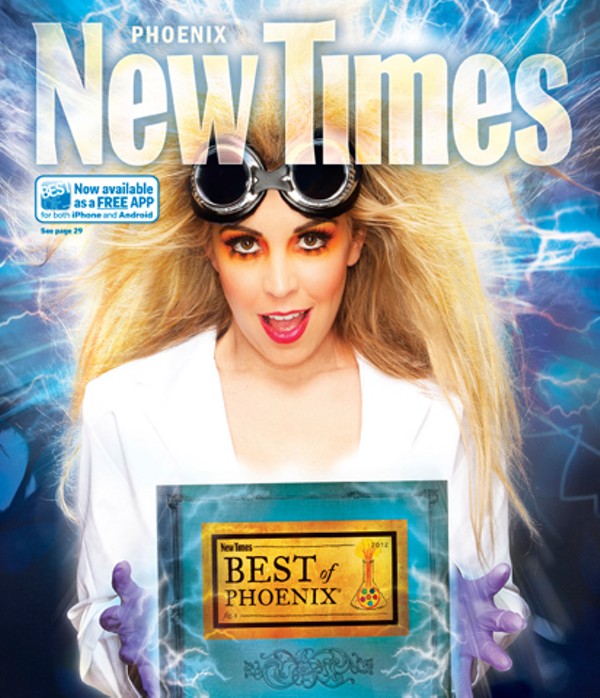At the end of a dirt road in South Mountain's Pima Canyon Entrance, tucked away in a quiet desert arroyo full of mesquite and cactus, you'll find a collection of boulders with names. These are the gems of South Mountain bouldering, a type of low-vertical climbing activity that usually involves rock shoes and a chalk bag but no rope. On nice days, you're likely to find climbers scampering around the Entrance, Africa and World boulders, or the "Amphitheater."
The routes here are mostly "clean," which in climber-speak means that the hand- and footholds aren't too likely to break off. South Mountain rock is notorious for coming apart, though, so be forewarned. This isn't Hueco Tanks or Red Rocks. But this area, reportedly developed by locals in the mid-1990s, does offer dozens of established routes, ranging from easy (VO) to ridiculously tough (V7). Basic route descriptions can be found in a popular pamphlet published by local climber Marty Karabin. When not crumbling, the rock here has a smooth yet textured feel that doesn't rip apart the skin as easily as the razor-rock of the popular Queen Creek bouldering area two hours east of Phoenix. Plus, the wash inhabited by the boulders can be a wonderfully peaceful and beautiful hangout — if you don't mind sharing it with the occasional rattlesnake.Best Bouldering
South Mountain
Best Rock Climbing
Little Granite Mountain
Without a state land permit, you may get harassed and ticketed by The Man on this crag. (If you want to keep it legit, call 602-542-2119 for permit info.) Either way, you'll enjoy some of the Valley's finest climbing if you head out to Little Granite Mountain in Scottsdale.
Called "little" to distinguish it from a much more impressive rock pile in Prescott, this granite mountain nonetheless has some walls that are higher than a 10-story building. That would include the moderately rated "Young Monkeys," a 120-foot slab with a couple of long blank sections a climber would not want to slip on. Another awesome moderate, "Sweet Surprise," offers a perfect hand-crack that thins to a finger-crack over 100 feet of climbing. Beginning and experienced lead climbers will find dozens of challenging, sometimes adventurous routes in the area, which includes several distinct crags used by climbers. The drive in is best done with a high-clearance and/or four-wheel-drive vehicle. From Dynamite Road, drive north on 136th Street on the dirt road to Powerline, go through a gate, then drive a little more until you find a place to park. Once you're on the trail system that wends its way through the various climbing areas (go online or find a guidebook, such as Phoenix Rock 2, for details) it should be easy going. As long as you brought that permit.Best Rock Climbing Gym
Phoenix Rock Gym

Rock climbing is a perishable skill. Thankfully, each time we find ourselves in too pathetic a state, we have the Phoenix Rock Gym to help with the necessary repairs. The two bouldering areas, including an upstairs room with sharply overhanging walls, are perfect for muscle-building and fingertip-hardening. Once we get back in shape, we usually can then find a partner who'll be willing to belay us on the 30-foot faces of the gym's main walls. Despite its friendly ambiance, the Valley's oldest rock gym has a hard side — we've ripped skin there, tweaked a limb on the lead wall, and worked our forearms until our hands could barely close. But it's all good. For inspiration, we look to the teens and tweens of Team Thrashers, the competitive climbing outfit that trains at the PRG under the tutelage of coach Jeremy Cox. Nothing motivates us to work out harder than watching a kid do 30 pull-ups without breaking a sweat.
- 1353 E. University Dr., Tempe, 85281 Map
- 480-921-8322
- www.phoenixrockgym.com
Best Batting Cages
The Cages

There are plenty of spots around the Valley that can fulfill the urge to hit a few baseballs. There are only a few places where you can feed your inner big-leaguer at an indoor facility and face curveballs, 85 mph fastballs, a delivery that simulates a human arm angle, or get instruction from former pros. You can get even more serious with a membership, allotting yourself time every day to perfect your swing. From Little League-age on up, The Cages is where players go to hit. Or you can keep hacking at the crap that comes out of the antique pitching machines that litter the outdoor batting cages around the Valley. There are a couple of extra alleys inside The Cages, so pitchers are welcome too.
- 2511 E. Bell Rd., Paradise Valley, 85032 Map
- 602-925-0607
- www.thecagesfacility.com
Best Place to See a Spring Training Game
Goodyear Ballpark

Old Hohokam Stadium, Phoenix Municipal Stadium, and Scottsdale Stadium stand as the last of the original Cactus League stadiums. The spring homes to 15 of the major leagues' teams have turned into sprawling multi-field complexes for a couple of teams to share. Character and warmth of the intimate training fields have been stripped so that fans can sit in pristine, generic stadiums at ticket prices nearing those sold during those teams' regular season. Yet one intimate fan experience still beckons, in the West Valley.
The Goodyear Ballpark, built in 2009, hosts the Cleveland Indians and Cincinnati Reds for their preseason practice and home games and has two very cool and unique features. The first and best is a mini-diamond, located beyond the right field foul line, for kids and families to play on during games. This space epitomizes a spring game experience, allowing kids and parents to watch the big leaguers for a few innings and then go and enjoy the beautiful game in their own way, right next to where the pros are doing it. The second is a large sculpture in front of the stadium called The Ziz by Donald Lipski. It looks like a giant baseball that has gone through some shape-shift warp. It's one of the few artistic touches at any spring training facility across the Valley. Bonus: There are some quality knothole views of the field from the fence behind the left field wall.- 1933 S. Ballpark Way, Goodyear, 85338 Map
- 623-882-3120
- www.goodyearbp.com
Best Place to See Former WWE Superstars
Future Stars of Wrestling's Adrenaline Rush
For most professional wrestlers, few things are as thrilling as hearing the roar of the crowd as they compete in the ring. In rasslin' parlance, it's called a "pop," and it can be addictive. Especially the massive rush of performing for tens of thousands of fans at televised extravaganzas as a superstar for World Wrestling Entertainment (a.k.a. the big leagues). Cheers from adoring WWE crowds can be so heady that many of the federation's ex-superstars attempt to recapture these glory days in front of much smaller crowds at various independent promotions across the country, if only to hear their names getting screamed once again. Here in the Valley, that means working events put on by the (ironically named) locally fed Future Stars of Wrestling, which frequently features a few erstwhile WWE competitors. Racy performers from the ultra-suggestive "Attitude Era" of the '90s, like "Badd Ass" Billy Gunn and Sean Morley (once known as porn-actor-turned-wrestler Val Venis) have previously faced off against FSW's roster of up-and-coming grapplers like Tyson Tyler and Willie Mack during biweekly Adrenaline Rush events at the Celebrity Theatre and other Valley venues. Other onetime WWE employees, including Johnny "The Bull" Stromboli and the villainous Iranian-born Shawn Daivari, also compete. Plus, they even get some television time once again via FSW's weekly television show, which airs Saturday nights at 11 p.m. on Channel 13. It's nowhere as spectacular as WrestleMania, but at least they're still getting cheered.
Best Mascot
The Gorilla
We gotta go with the Gorilla. We're not expecting much else to be good about the Phoenix Suns this year, but the Gorilla will remain a crowd-pleaser with his death-defying leaps, his goofy antics, and his public appearances around the world on behalf of various worthy causes. According to the Suns' website, he attended Fur-man University and Hairy Truman High School in Mon-key West, Florida, and has been a pro for 27 years (which translates to 59 gorilla years).
Despite the corny credentials, he's a force to be reckoned with in the mascot world around here. A gymnast of King Kong talent, the man inside the ape suit literally jumps off trampolines through rings of fire to slam-dunk basketballs, and has broken nearly every bone in whatever body occupies his furry skin. An irate Miami Heat fan once punched him in the snout, not appreciating his monkeyshines. The Gorilla's identity? Reportedly, it's a middle-aged balding dad named Bob Woolf, but who knows who's really inside that furry skin, says the coy Suns organization. In early September, the Suns announced they were seeking a new apeman to fill the suit and the $40,000-a-year job. Well — Woolf in gorilla's clothing or whoever it is or will be in 2012-13 — he's got no competition in the world of Valley mascots. Sheesh, the Arizona Cardinals' Big Red scares the crap out of us with that gigantic pointed beak and gleam in his eye, the Phoenix Coyotes' Howler never has done anything funny or death-defying, and we're pretty sure everybody agrees that the Diamondbacks' Baxter is kinda pathetic. We mean, why do we have a bobcat as the team's mascot? Oh, yeah, Chase Field used to be called Bank One Ballpark. D-backs, it's not anymore! Hasn't been for a looong time! Time to retire the idiotic Baxter and move on to a cute, cuddly rattlesnake man.Best Superfan
Cindy "The Flag Lady" McBride
Being a fan of the Arizona Diamondbacks the past few seasons is akin to being on a roller coaster. In 2009 and 2010, the team found itself dwelling in the dank depths of the National League West standings. Then, the absolutely unthinkable happened last year, when skipper Kirk Gibson took Arizona from worst to first, leading them all the way to an unlikely playoff run. This year, however, they have struggled off and on. While fair-weather types have stayed away from Chase Field, Cindy McBride hasn't abandoned her "Boys in Sedona Red." In fact, the 66-year-old Tempe dental assistant has never missed a home game in more than a decade, be it a good season or bad. She's arguably the team's most diehard fan and definitely its most colorful supporter. Starting in 2002, McBribe began bringing homemade flags to every single contest at the Chase (as well as the occasional road game), which she waves energetically from her seat in the nosebleeds of the upper deck. Created in her spare time, each one utilizes the team's colors and is designed with unique patterns for specific players. Due to her tendency to shuffle about in the stands and fly flags when the D-backs are behind, announcers originally dubbed her "Dancing Granny" or "Rally Sally." These days, McBride is known as just "The Flag Lady" and has been waving her pennants extra-hard, if only to encourage the Diamondbacks to rally toward another NL playoff spot.
Best Play-by-Play Announcer
Al McCoy, Phoenix Suns
A couple of years ago, the folks at Channel 3 pulled a major boner by running an erroneous headline on their website stating that legendary longtime Phoenix Suns radio announcer Al McCoy was hanging up his microphone and retiring. Much to the relief of Planet Orange fans everywhere (ourselves included), it thankfully turned out to be completely false. Because, honestly, we can't imagine Phoenix taking to the court without McCoy's distinctive voice describing all the action from buzzer to buzzer. Having called Suns games for more than four decades, the former Iowa farm boy is as much a part of the team as anyone on the current roster. His signature catchphrases (like "Shazam!" after the Suns make a three-pointer or "Heartbreak Hotel" after a missed shot) are the stuff of legend, as are the humorous nicknames given to players (such as Steve Nash's becoming the "Nash Rambler.") McCoy's set to turn 80 next year, but he hasn't shown any inkling of quitting. Here's hoping the Suns finally get their shizzle together to win an NBA championship before he retires. We're sure Al's as eager to call that moment as we are to hear it.
Best Coach
Dave Tippett
Before Dave Tippett hit town, we thought ice hockey had two halves and four quarters, just like basketball and football. The Phoenix Coyotes head coach has brought hockey intelligence to this desert metropolis. Like they say, winning puts fannies in the seats, and it made us learn not only that there are three periods in a hockey game, but also that hockey is a fast-paced, thrill-a-minute sport that makes even the National Basketball Association pale by comparison.
Sure, the Coyotes had star forward Shane Doan and phenomenal goalie Mike Smith, but without Tippett, the Coyotes never would have pulled off their incredible 2011-12 season, in which they lost in the Western Conference finals to the eventual Stanley Cup-champion Los Angeles Kings in five games. Before that even happened, with Tippett pulling the strings, the Yotes won their first-ever Pacific Division title with a 42-27-13 record. They went on to smash the heralded Chicago Blackhawks in six games for the franchise's first playoff series win in 25 years (they were the Winnipeg Jets before moving to the Valley in 1996). After that, they prevailed over the Nashville Predators in five games, giving them the most playoff wins in their NHL history.
And though Tippett never laced up a pair of skates, he was the chess master who made it happen. Let's pray now that the Yotes' financial problems can be solved and Tippett and the Yotes can remain here for good. We need a good team in Sand Land — our mental health demands it.






